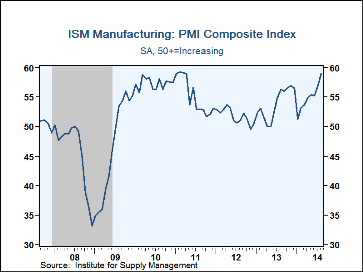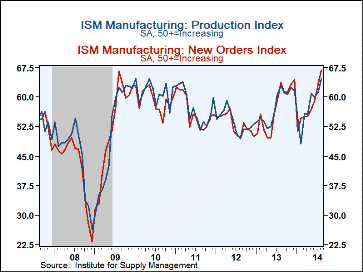 Global| Sep 02 2014
Global| Sep 02 2014U.S. ISM Manufacturing Index Continues to Climb in August
by:Sandy Batten
|in:Economy in Brief
Summary
The U.S. manufacturing sector continued its solid rebound as the Institute for Supply Management's index of manufacturing sector activity jumped to 59.0 in August from 57.1 in July and 55.3 in June. The August move was much larger [...]
The U.S. manufacturing sector continued its solid rebound as the Institute for Supply Management's index of manufacturing sector activity jumped to 59.0 in August from 57.1 in July and 55.3 in June. The August move was much larger than the consensus expectation for a modest rise to 57.3 as measured by Action Economics Forecast Survey. Any figure above 50 for this measure indicates increasing manufacturing activity. This was the third consecutive monthly increase in the index which now stands at its highest level since March 2011 and its third highest level of the current expansion (which began in July 2009). Over the past decade, there has been a 75% simple correlation between the level of the ISM manufacturing index and the quarterly percent change in real GDP. So, the continued upward march of the ISM index in August points to continued robustness in GDP growth.
The August strength was led by the orders and production components of the headline index. The most forward looking component of the report, the new orders index, surged to 66.7 in August from 63.4 in July, its highest reading of the current expansion and indeed, its highest reading since April 2004. The production index jumped up to 64.5 in August from 61.2 in July. This is the production measure's highest level since May 2010 and its third highest reading of this expansion.
The employment index essentially held on to its July gains in August, slipping slightly to 58.1 from 58.2 the previous month. This index remains around its highest level since mid-2011 and indicates that employment gains are solidifying.
Apart from the headline index and its components, the export orders index rebounded to 55.0 in August but remains on a general downtrend for 2014. Similarly, the imports index in August regained some of its ground lost in July, but amid its volatility, it has been essentially flat during 2014.
The prices index retreated in August after a July jump, falling back to the June level. Compared to its history, the prices index has fluctuated in a relatively narrow range during 2014 and does not seem to point to any imminent inflation or deflation issues.
The figures from the Institute For Supply Management (ISM) are diffusion indexes and can be found in Haver's USECON database. The expectations number is in the AS1REPNA database.
| ISM Mfg | Aug | Jul | Jun | Aug'13 | 2013 | 2012 | 2011 |
|---|---|---|---|---|---|---|---|
| Composite Index | 59.0 | 57.1 | 55.3 | 56.3 | 53.9 | 51.8 | 55.2 |
| New Orders | 66.7 | 63.4 | 58.9 | 63.6 | 57.2 | 53.1 | 56.4 |
| Production | 64.5 | 61.2 | 60.0 | 63.0 | 57.7 | 53.8 | 57.4 |
| Employment | 58.1 | 58.2 | 52.8 | 55.0 | 53.2 | 53.8 | 57.4 |
| Supplier Deliveries | 53.9 | 54.1 | 51.9 | 52.4 | 51.9 | 50.0 | 54.7 |
| Inventories | 52.0 | 48.5 | 53.0 | 47.5 | 49.4 | 48.2 | 50.1 |
| Prices Paid Index (NSA) | 58.0 | 59.5 | 58.0 | 54.0 | 53.8 | 53.2 | 65.2 |
Sandy Batten
AuthorMore in Author Profile »Sandy Batten has more than 30 years of experience analyzing industrial economies and financial markets and a wide range of experience across the financial services sector, government, and academia. Before joining Haver Analytics, Sandy was a Vice President and Senior Economist at Citibank; Senior Credit Market Analyst at CDC Investment Management, Managing Director at Bear Stearns, and Executive Director at JPMorgan. In 2008, Sandy was named the most accurate US forecaster by the National Association for Business Economics. He is a member of the New York Forecasters Club, NABE, and the American Economic Association. Prior to his time in the financial services sector, Sandy was a Research Officer at the Federal Reserve Bank of St. Louis, Senior Staff Economist on the President’s Council of Economic Advisors, Deputy Assistant Secretary for Economic Policy at the US Treasury, and Economist at the International Monetary Fund. Sandy has taught economics at St. Louis University, Denison University, and Muskingun College. He has published numerous peer-reviewed articles in a wide range of academic publications. He has a B.A. in economics from the University of Richmond and a M.A. and Ph.D. in economics from The Ohio State University.








